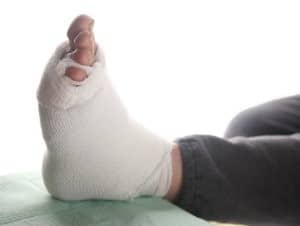Diabetic Damage: Charcot Foot
Diabetes has a plenty of negative side effects for your health, damaging nerves and blood vessels, increasing your risk for serious and even life-threatening infections, and so on. What many people don’t quite understand is how it can collapse and severely deform feet, restricting your mobility and independence—and possibly leading to limb amputations. Charcot foot is a slow break down of bones that allows your foot to collapse from diabetes.
How a Diabetic Foot Collapses
The high or fluctuating blood sugar levels that come with diabetes wreak havoc on the human body. They damage blood vessels, impair nerves, and ruin both organs and even your bones. All these issues together can lead to bones breaking down into a diabetic foot collapse.
Numbness and nerve pain from severe peripheral neuropathy can prevent you from feeling injuries of all kinds, from little blisters to stress fractures in your bones. When the bones are weakened by diabetes, pressure and repetitive impacts can crack and damage bone tissue more easily than normal. Because you can’t feel pain from this injury, however, you continue walking around, putting pressure on those cracks and widening them. As more cracks appear and worsen over time, your foot starts to collapse.
Eventually the bones break down and become seriously deformed. Your foot develops a high risk for ulcers because the collapsed bones aren’t able to support pressure correctly. Tissues in your foot may start to die or develop serious infections. Without emergency foot care, your limb might end up amputated.
Signs of Charcot Foot
Because severe neuropathy means you can’t feel your foot collapsing, symptoms of the problem are much harder to catch. Usually you’ll notice swelling in your foot first, even though there may not be an obvious injury. Your skin may appear red and feel warm to the touch as well. As the Charcot foot worsens, you may notice your arch appearing flatter or areas of your foot becoming deformed. Ulcers may develop in odd places. You might eventually notice some degree of soreness and pain as well.
Rebuilding and Restoring the Lower Limbs

When the break-down is caught early, you may only need conservative care. Your foot will have to be immobilized in a brace or cast to hold the bones still enough to heal in their correct positions. You won’t be able to put any weight on that foot during your recovery, either. Your cast will be changed regularly to make sure it continues to fit and immobilize your limb correctly as swelling decreases. Once your bones have healed enough that you can being walking on that foot again, you’ll need to wear special shoes or custom orthotics to make sure your limbs receive the support they need.
More serious diabetic foot collapse may require surgery to reconstruct the broken-down parts of your feet. This may involve using pins or other hardware to ensure the bones stay correctly in place while they heal. After the surgery, your foot will be casted and begin the recovery process.
Charcot foot is a very serious condition that could have permanent consequences, but your feet don’t have to reach that point. Regular diabetic foot care and inspecting your lower limbs for changes daily can make a big difference in protecting your feet from traumatic damage. Instead of dealing with a collapsed foot, let The Kansas Foot Center help you manage your diabetic foot care to keep your lower limbs healthy. Call our Wichita office at (316) 283-4330 for more information or to schedule a consultation today.
